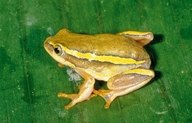|
Description
Males are 25-28 mm while females are 26-30 mm in total length. Greenish, with distinct yellowish dorsolateral bands which extend onto the tibia. The dorsolateral stripes are more distinct in females. The gular gland is slightly heart-shaped.
Similar species: In H. betsileo, H. "variabilis" and H. andrakata the dorsolateral bands do not extend to the thighs.
Distribution and Habitat
Country distribution from AmphibiaWeb's database: Madagascar
Ambalabongo, Ambanja, Ampijoroa, Andafiabe, Andranolava (TL), Ankarafantsika, Tsingy de Bemaraha (Antranopasasy), Ihosy, Kandani, Kirindy, Mahajanga, Morondava, West of Ihosy, Ranohira, Vohibasia forest. Observed at elevations from sea level to 800 m in dry forests, deforested areas, and agricultural areas, usually rice fields (Nussbaum et al. 2008).
Life History, Abundance, Activity, and Special Behaviors
Call: A series of unharmonious short notes (note type 2). Four analyzed calls consisted of 17-24 notes and had a duration of 2800-4000 ms, with intervals between calls of 2000 ms. Note duration is 16-26 ms, duration of intervals between notes is 142-167 ms. Note repetition rate is 6/s. Frequency ranges from 2.5 to 4 kHz. Sometimes a second note type (type 1) could be heard (duration 400-600 ms, consisting of about 40 pulses), and rarely this note type 1 was immediately followed by a note series of notes of type 2, resulting in a call that is similar to those of Heterixalus madagascariensis and H. boettgeri.
Calls from Ampijoroa (ca. 22 �C) have a note duration of 102-137 ms, a note repetition rate of 5/s, a frequency between 1.5 to 8.0 kHz (dominant frequency about 3.5 kHz).
Freshly laid eggs and calling males were found in January in rice fields and swamps. They were sitting at night at the edge on the bottom or on vegetation 5-10 cm above water. Yellowish eggs were found in a rice field in January. Tadpoles reared from these eggs were similar to those of other species of Heterixalus. Young tadpoles (stage 25) had a body length of 7.5-10 mm and a total length 17.5-25 mm (fig. 196). Tooth formula was 1//1+1/2.
Breeding takes place in permanent and temporary still waters, including rice fields (Nussbaum et al. 2008). Trends and Threats
It occurs in Parc National de Isalo and Parc National d'Ankarafantsika, and possibly in other protected areas (Nussbaum et al. 2008). Comments
Taken with permission from Glaw and Vences (2007).
References
Glaw, F., and Vences, M. (2007). Field Guide to the Amphibians and Reptiles of Madagascar. Third Edition. Vences and Glaw Verlag, Köln.
Nussbaum, R., Andreone, F., and Vences, M. (2008). Heterixalus luteostriatus. In: IUCN 2008. 2008 IUCN Red List of Threatened Species. www.iucnredlist.org. Downloaded on 21 April 2009.
Originally submitted by: Miguel Vences and Frank Glaw (first posted 2002-02-01)
Edited by: Henry Zhu (2010-07-18)Species Account Citation: AmphibiaWeb 2010 Heterixalus luteostriatus <https://amphibiaweb.org/species/490> University of California, Berkeley, CA, USA. Accessed Jan 21, 2025.
Feedback or comments about this page.
Citation: AmphibiaWeb. 2025. <https://amphibiaweb.org> University of California, Berkeley, CA, USA. Accessed 21 Jan 2025.
AmphibiaWeb's policy on data use.
|
